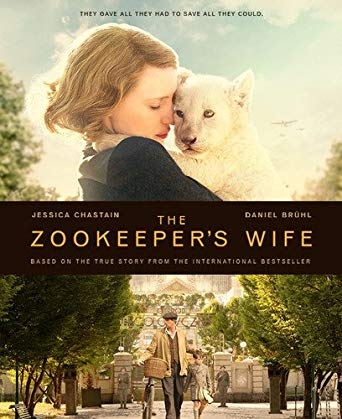| Title: | The Zookeeper’s Wife |
| Director: | Niki Caro |
| Cast: | Jessica Chastain, Daniel Bruhl, Iddo Goldberg, Johan Heldenbergh et al. |
| Released: | 2017 |
| Publisher: | Universal Pictures Home Entertainment |
| Playtime: | 120 minutes |
| Description: | It took ten years before the book "The Zookeeper's Wife" by the American writer Diane Ackerman was filmed. Released in the Netherlands as ''Antonina's Zoo - A War Story in Warsaw', this historical-based novel tells the special war story of the Polish Antonina, wife of Jan Zabinski; director of the Warsaw zoo before the Second World War. Around 300 Jews were rescued from the Nazis by the couple during the war. They stayed, for a short or long time, in hiding on the grounds of the zoo or in the villa of the Zabinskis. The people in hiding were almost the only inhabitants of the zoo, since many animals perished during the German bombardment of the city in September 1939 or were killed because of the danger that they might escape. Other animals were killed by the Germans or taken to German zoos as spoils of war. It was the Lutz Heck, the director of the Berlin zoo, who contributed to the collapse of the zoo in Warsaw. Shortly after the German victory, he appeared at the zoo to take away several animals. In the film, however, his role is made much bigger than it was. We see how he, in the uniform of an SS officer, occupies an important position within the German authorities in the Polish capital until 1944. He makes an agreement with Antonina, which allows her and her husband to stay in the zoo, but for which the woman pays a high price. She had to tolerate the advances of the SS officer, for fear that he would have her and her husband removed from their home That would have meant the end of the people in hiding who were given a safe place in the zoo, in empty, underground animal cages. The villain cannot be missed in a Hollywood film, but the facts are deceitful and at the expense of a person who can't defend himself anymore, because Heck died in 1983. You can safely consider Lutz Heck, as a member of the Nazi party and (inactive) member of the SS, as a Nazi. In addition, he was a good (hunting) friend of Imperial Marshal Hermann Göring and he held a leading position within his Reichsforstamt (a kind of state forest management). The zoologist, however, was never part of the Nazi regime in Warsaw and had no interest whatsoever in arresting Jewish people in hiding in the Warsaw zoo, as is true for his character in the film. What remotely corresponds to the truth in the film, is the breeding programme he was involved in. Together with his brother Heinz, he wanted extinct animals, such as the primeval cattle and horse, to return to German nature areas, through the crossbreeding of animals with certain distinct "primitive" characteristics. A result of this, the Heck cattle, is currently found in the Dutch nature reserve, the Oostvaardersplassen (for more information about Lutz Heck read: "War Zone Zoo"). Apart from the criminalisation of Lutz Heck, other elements in the film do not do justice to the truth either. For example, it is a fabrication that Jan Zabinski smuggled Jewish refugees from the Warsaw Ghetto, by hiding them under potato and vegetable peelings in a truck. His collaboration in rescuing Jews with a German ghetto employment agency is also not a proven fact. However, the larger historical events, such as the eviction of the ghetto (rebellion in the Warsaw ghetto) and the Polish revolt in Warsaw in 1944, are faithfully depicted. In addition, elements from other films have been copied, such as the story of the Jewish paediatrician and pedagogue, Janusz Korczak, who refused to go into hiding because he did not want to abandon the children from his orphanage when they were deported to the Treblinka extermination camp. He and the children were executed there in the gas chambers. Korczak's sacrifice was similarly depicted in "The Pianist" from 2002. Actually, the scene in which the zoo is bombed by the Germans is the most impressive. The panic that breaks out among the animals and the animal suffering that was inflicted, touches the heart of every animal lover. Strangely enough, the filmmakers do not succeed in evoking the same feeling in the scenes about the Holocaust where, rationally speaking, the destruction of a zoo pales in comparison. Perhaps it is because the story of the persecution of the Jews has been filmed many times, while animal suffering is not a common theme in war movies. Apart from that, "The Zookeeper's Wife" has little to add to earlier war films. Clichés and predictable drama were safely chosen. What the filming of the story of the Zabinski's does succeed in doing, is to make known to a wide audience their heroism, which is certainly not fictional. Anyone who does not care that the film is not truthful and who has seen few other Holocaust films, will nevertheless be captivated by this film, in which the historical image of the time, with all its horrors for man and animal, is correctly depicted. |
| Rating: |    (Good) (Good) |
Information
- Translated by:
- Fernando Lynch
- Article by:
- Kevin Prenger
- Published on:
- 22-04-2019
Images


